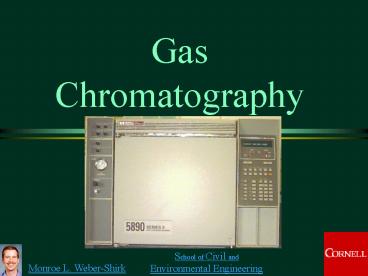Gas Chromatography - PowerPoint PPT Presentation
1 / 21
Title:
Gas Chromatography
Description:
... an overview What is chromatography History of chromatography Applications Theory of operation Detectors What is Chromatography color writing ... – PowerPoint PPT presentation
Number of Views:274
Avg rating:3.0/5.0
Title: Gas Chromatography
1
Gas Chromatography
2
Come to lab prepared to work on a variety of tasks
- Map the location of a VOC spill
- Load samples vials with soil for next weeks lab
- Review your WWTP data logs to see how the plant
is operating - Measure pH and MLVSS of WWTP
- Design a better HMI (or GUI)
3
Gas Chromatographan overview
- What is chromatography
- History of chromatography
- Applications
- Theory of operation
- Detectors
4
What is Chromatography
- color writing
- the separation of mixtures into their
constituents by preferential adsorption by a
solid (Random House College Dictionary, 1988) - Chromatography is a physical method of
separation in which the components to be
separated are distributed between two phases, one
of the phases constituting a ______________ of
large surface area, the other being a ______ that
percolates through or along the stationary bed.
(Ettre Zlatkis, 1967, The Practice of Gas
Chromatography)
stationary bed
fluid
5
History of Chromatography
- 1903 - Mikhail Tswett separated plant pigments
using paper chromatography - liquid-solid chromatography
- 1930s - Schuftan Eucken use vapor as the
mobile phase - gas solid chromatography
6
Gas Chromatography Applications
gas
- Compound must exist as a ____ at a temperature
that can be produced by the GC and withstood by
the column (up to 450C) - Alcohols in blood
- Aromatics (benzene, toluene, ethylbenzene,
xylene) - Flavors and Fragrances
- Permanent gases (H2, N2, O2, Ar, CO2, CO, CH4)
- Hydrocarbons
- Pesticides, Herbicides, PCBs, and Dioxins
- Solvents
Depending on the column
7
Advantages of Gas Chromatography
- Requires only very small samples with little
preparation - Good at separating complex mixtures into
components - Results are rapidly obtained (1 to 100 minutes)
- Very high precision
- Only instrument with the sensitivity to detect
volatile organic mixtures of low concentrations - Equipment is not very complex (sophisticated oven)
8
Chromatogram of Gasoline
1. Isobutane2. n-Butane3. Isopentane4.
n-Pentane5. 2,3-Dimethylbutane6.
2-Methylpentane7. 3-Methylpentane8. n-Hexane9.
2,4-Dimethylpentane10. Benzene11.
2-Methylhexane12. 3-Methylhexane13.
2,2,4-Trimethylpentane14. n-Heptane15.
2,5-Dimethylhexane16. 2,4-Dimethylhexane17.
2,3,4-Trimethylpentane18. Toluene19.
2,3-Dimethylhexane20. Ethylbenzene21.
m-Xylene22. p-Xylene23. o-Xylene
9
Theory of Operation
- Velocity of a compound through the column depends
upon affinity for the stationary phase
Area under curve is ______ of compound adsorbed
to stationary phase
mass
Carrier gas
Gas phase concentration
10
Process Flow Schematic
Detector (flame ionization detector or FID)
Sample injection
Carrier gas (nitrogen or helium)
Air
Hydrogen
Long Column (30 m)
11
Gas Chromatograph Components
top view
Flame Ionization Detector
Injection Port
Column
Oven
front view
12
Flame Ionization Detector
Teflon insulating ring
Coaxial cable to Analog to Digital converter
Gas outlet
Collector
Ions
Flame
Sintered disk
Platinum jet
Air
Hydrogen
Why do we need hydrogen?
Capillary tube (column)
13
Flame Ionization Detector
ions
- Responds to compounds that produce ____ when
burned in an H2-air flame - all organic compounds
- Little or no response to (use a Thermal
Conductivity Detector for these gases) - CO, CO2, CS2, O2, H2O, NH3, inert gasses
- Linear from the minimum detectable limit through
concentrations ____ times the minimum detectable
limit
107
14
Gas Chromatograph Output
- Peak ____ proportional to mass of compound
injected - Peak time dependent on ______ through column
area
Strip chart technique?
velocity
detector output
time (s)
15
Other Detectors
- Thermal Conductivity Detector
- Difference in thermal conductivity between the
carrier gas and sample gas causes a voltage
output - Ideal carrier gas has a very ____ thermal
conductivity (He) - Electron Capture Detector
- Specific for halogenated organics
low
16
Advantage of Selective Detectors
TCE
Mixture containing lots of methane and a small
amount of TCE
FID output
methane
time
ECD output
time
17
Mass Spectrophotometer
- Uses the difference in mass-to-charge ratio (m/e)
of ionized atoms or molecules to separate them
from each other. - Molecules have distinctive fragmentation patterns
that provide structural information to identify
structural components. - The general operation of a mass spectrometer is
- create pure gas-phase ions ( __________________ )
- separate the ions in space or time based on their
mass-to-charge ratio - measure the quantity of ions of each
mass-to-charge ratio
Gas chromatograph
18
Mass Spec Output
- Each peak of a chromatogram becomes a
fingerprint of the compound - The fingerprints are compared with a library to
identify the compounds
mass-to-charge ratio
19
Purge and Trap
- Way to measure dilute samples by concentration of
constituents - Trap constituents under low temperature
- Heat trap to release constituents and send to GC
column
N2
Trap
20
Techniques to Speed Analysis
- Problem some components of a mixture may have
very high velocities and others extremely low
velocities. - slow down fast components so they can be
separated - speed up slow components so analysis doesnt take
forever - Solution
21
Temperature Control Options













![Lecture note : Gas chromatography [1] ????????? PowerPoint PPT Presentation](https://s3.amazonaws.com/images.powershow.com/6692254.th0.jpg?_=20150604093)

















